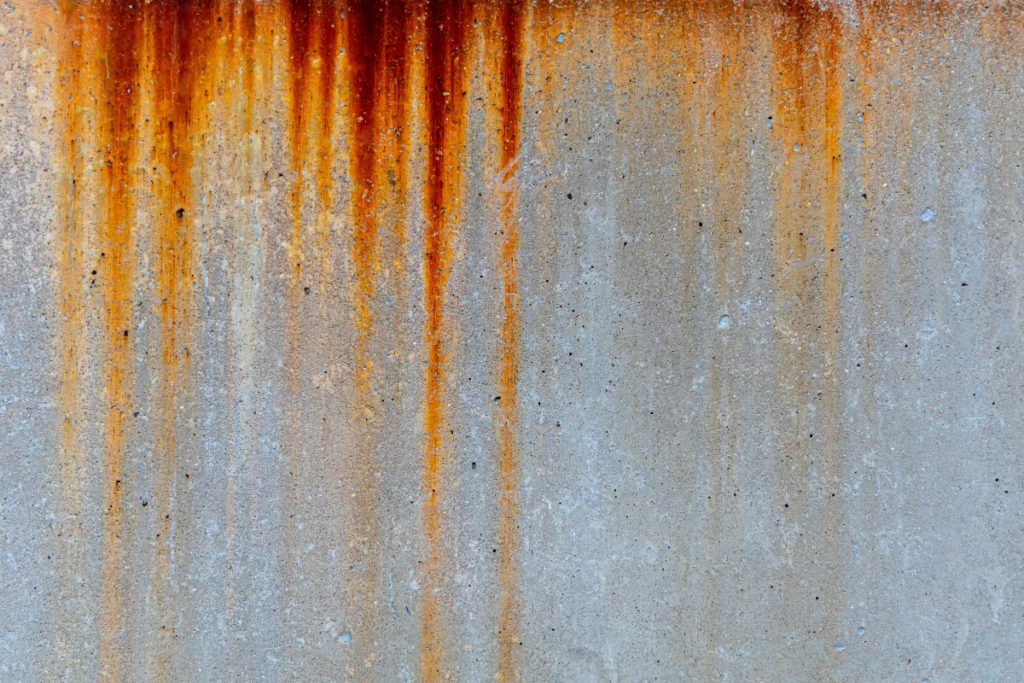If you’ve ever left aging metal tools or furniture on a patio or driveway, you’ve likely ended up with unsightly orange or brown rust stains. Fortunately, you can remove these stains yourself if you know the proper procedure. Read on to learn the best way to clean rust stains from concrete.
Removing Small Stains
If you have minor rust stains, they should be relatively easy to remove with an acidic solution. That said, if your concrete is stained or painted, you should dilute the solution with equal parts water. You should also use a soft-bristled brush that won’t strip away the existing finish.
Begin by thoroughly cleaning the concrete with a water-based dish soap and water. This will help wash away any surface-level dirt or grease that might act as a barrier and prevent the acidic solution from removing the stain.
Once the concrete is clean, soak the stain in pure lemon juice. Allow it to steep for 15 minutes; then scrub the spot using a wire brush. If your concrete is stained, painted, delicate or brittle, use a nylon brush instead.
Next, thoroughly rinse the spot with clean water and allow it to dry. You may need to repeat the process several times to fully eliminate the stain. If the rust stain is especially stubborn or deep, you can try white vinegar instead of lemon juice. Bear in mind, however, that vinegar is more likely to strip away paint or stained finishes.
Removing Significant Rust Stains
Some rust stains will permeate concrete too deeply for lemon juice or vinegar to work. In this case, you will need to use a stronger acid.
Purchase a rust removing agent that contains oxalic acid. You may also have success with trisodium phosphate or hydrochloric acid. Bear in mind, however, that these acids can damage or discolor your concrete if left in place for too long. Whatever acid you choose, mix one-part water and two parts acid to minimize the risk of damage.
When working with acidic solutions, it’s very important to follow the safety precautions printed on the bottle. Wear acid-proof gloves, eye protection, long-sleeved shirts and pants. You may also want to wear an acid-proof apron. If you are working in an enclosed area, such as a garage or basement, wear a respirator.
Once you have taken steps to protect yourself, follow a similar process you used when applying the lemon juice. Thoroughly clean the surface and then apply the diluted acid according to the labels on the bottle. Allow the solution to sit for 10 minutes; then scrub the area using a nylon brush. Apply baking soda to neutralize the acid; then rinse the area using clean water. For very stubborn stains, you may need to rinse the acid and stain away using a pressure washer.
Things to Consider
Because acid can be incredibly dangerous, it requires special care. While it may seem like overkill, it’s best to err on the side of caution when it comes to safety.
Minimize the risk of burns by wearing acid-resistant gloves, rubber boots and vapor-proof goggles. If you’re working in a basement or enclosed area, it’s important to wear a respirator with a professional, acid-grade filter. You should also wear a face shield, protect any exposed skin with clothing, and wear a PVC or butyl apron or coveralls.
It’s also a good idea to keep fresh water on hand to rinse away spills from skin or clothing. Keep baking soda or garden lime nearby to neutralize any acid spills. Work slowly to minimize the risk of accidents and don’t skip steps or rush through any part of the process.
Refreshing Concrete Surfaces
Whether it’s due to stains, sinking or cracking, concrete surfaces can become ugly and less functional over time. Fortunately, you can easily refresh your concrete if you know who to call. If your concrete is cracking or sagging, you can have it restored at an attractive price using mudjacking techniques, perfected by AAA Concrete Raising.
Give us a call or contact us online and we can level your concrete surface, restoring its function and aesthetic appeal.
